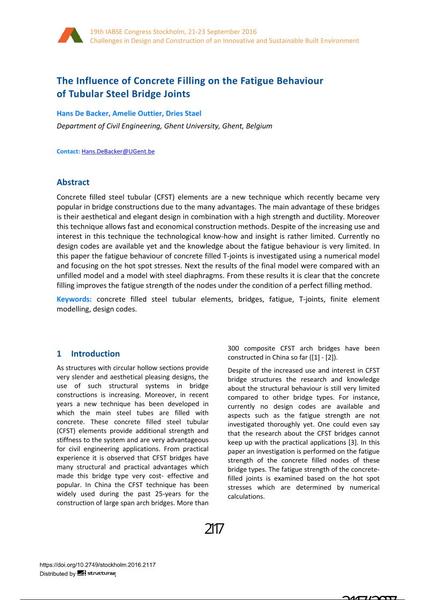The Influence of Concrete Filling on the Fatigue Behaviour of Tubular Steel Bridge Joints

|
|
|||||||||||
Détails bibliographiques
| Auteur(s): |
Hans De Backer
Amelie Outtier (Department of Civil Engineering, Ghent University, Ghent, Belgium) Dries Stael (Department of Civil Engineering, Ghent University, Ghent, Belgium) |
||||
|---|---|---|---|---|---|
| Médium: | papier de conférence | ||||
| Langue(s): | anglais | ||||
| Conférence: | IABSE Congress: Challenges in Design and Construction of an Innovative and Sustainable Built Environment, Stockholm, Sweden, 21-23 September 2016 | ||||
| Publié dans: | IABSE Congress Stockholm, 2016 | ||||
|
|||||
| Page(s): | 2117-2124 | ||||
| Nombre total de pages (du PDF): | 8 | ||||
| Année: | 2016 | ||||
| DOI: | 10.2749/stockholm.2016.2117 | ||||
| Abstrait: |
Concrete filled steel tubular (CFST) elements are a new technique which recently became very popular in bridge constructions due to the many advantages. The main advantage of these bridges is their aesthetical and elegant design in combination with a high strength and ductility. Moreover this technique allows fast and economical construction methods. Despite of the increasing use and interest in this technique the technological know-how and insight is rather limited. Currently no design codes are available yet and the knowledge about the fatigue behaviour is very limited. In this paper the fatigue behaviour of concrete filled T-joints is investigated using a numerical model and focusing on the hot spot stresses. Next the results of the final model were compared with an unfilled model and a model with steel diaphragms. From these results it is clear that the concrete filling improves the fatigue strength of the nodes under the condition of a perfect filling method. |
||||
| Mots-clé: |
ponts
|
||||

